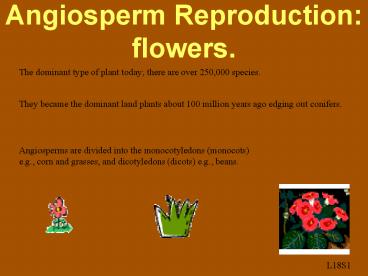Angiosperm Reproduction: flowers. - PowerPoint PPT Presentation
1 / 23
Title:
Angiosperm Reproduction: flowers.
Description:
There are generally hermaphrodite flowers and cross pollination between flowers ... Hermaphrodite: organism with the organs of both sexes. ... – PowerPoint PPT presentation
Number of Views:543
Avg rating:3.0/5.0
Title: Angiosperm Reproduction: flowers.
1
Angiosperm Reproduction flowers.
The dominant type of plant today there are over
250,000 species.
They became the dominant land plants about 100
million years ago edging out conifers.
Angiosperms are divided into the monocotyledons
(monocots) e.g., corn and grasses, and
dicotyledons (dicots) e.g., beans.
L18S1
2
The angiosperms
L18S2
Greek
3
Angiosperms
Why are there do many species?
Mosses
Ferns
Why are there so many species?
Conifers
L18S3
4
L18S4
West Gondwana, equivalent to modern South America
plus Africa
Angiosperms probably originated in the tropics
Gondwanaland
5
Three differences between gymnosperms and
angiosperms in reproduction
Angiosperm ovules are protected within an
enclosed structure rather sitting on a modified
leaf
Double fertilization in the angiosperms produces
a diploid zygote and triploid endosperm nucleus
There are generally hermaphrodite flowers and
cross pollination between flowers is typical
(70). Wind pollination is usual in the
gymnosperms. Animal pollination widespread in
angiosperms
L18S5
6
Basic structure of the angiosperm flower
This is a hermaphrodite flower with a single
carpel
Fig. 17.9b, p. 354
L18S6
7
Collective nouns that can cause confusion!
L18S7
8
More collective nouns that can cause confusion!
L18S8
9
Evolution of the pistil
Angiosperm ovules are protected within an
enclosed structure rather sitting on a modified
leaf as in the gymnosperms
L18S9
Remember, angeion case this is how we think it
evolved
10
Life cycle of Angiosperms
The basic life cycle appears similar to that of
the Gymnosperms
there is a well developed receiving system for
the pollen so that the male gametophyte can
penetrate the angion,
the female gametophyte has a more complex
structure that results in an endosperm, nutritive
material for the embryo
L18S10
11
Overview of cherry life cycle
Your book Fig 17.10 p 355
This figure is a lot better
Flower
Ovule formation
Seedling
Seed
Diploid Stage
Meiosis
Meiosis
Double Fertilization
Haploid Stage
Pollen development
Development of embryo sac
Pollination
L18S11
12
How pollen grains develop and germinate
(see next slide)
Diploid Stage
Meiosis
Haploid Stage
(see next slide)
Fig. 31.10 p 633
mature male gametophyte
L18S12
13
Double fertilization in the angiosperms produces
a diploid zygote and triploid endosperm
Ways in which Angiosperms are different from
Gymnosperms
L18S13
14
Somatic cell division involves two successive
steps mitosis and cytokinesis
Now, remind me, what is cytokinesis again ?
In mitosis, the nuclear DNA duplicates and
chromosomes segregates equally between the two
daughter nuclei
cytokinesis divides these two nuclei and
cytoplasm, including related cytoplasmic
organelles, into two individual cells.
L18S14
15
The fertilization process in Angiosperms
seedling (2n)
L18S15
Diploid Stage
Double Fertilization
Meiosis
Haploid Stage
One sperm nucleus to the egg, one to the
endosperm mother cell
Cytoplasmic division then gives 7 cells the
endosperm mother cell with 2 nuclei
Fig. 31.10, p. 633
16
What goes on in the endosperm?
The triploid nucleus divides and the endosperm
cell becomes a supercell with many nuclei and a
milky consistency.
Cyotkinesis forms membranes and walls between the
nuclei and makes the endosperm more solid.
In most dicotyledons the developing embryo moves
the nutrients stored in the endosperm to the
cotyledons and the endosperm is not present in a
mature seed.
In moncotyledons the endosperm remains and is
used by the seedling after germination.
L18S17
17
Look what happens when you eat your endosperm!
L18S18
18
In the angiosperms there are generally
hermaphrodite flowers and cross pollinating
(70). Wind pollination is typical in the
gymnosperms animal pollination widespread in
angiosperms
Hermaphrodite organism with the organs of both
sexes.
L18S19
How can self-fertilization be prevented for
hermaphrodite flowers?
1 Differences in timing of maturity of male
and female parts
2 Incompatibility mechanisms
19
Pollen and stigma incompatibility
There can be dozens of alleles of the S-gene. If
a pollen grain has an allele that matches an
allele of the stigma upon which it lands, then
the pollen tube fails to grow.
This system prevents self-fertilization AND
fertilization from close relatives.
L18S20
20
Rye grass incompatibility
Pollen Grain Size and Surface Morphology in a
Perennial Rye Grass Hybrid
Attempts to hybridize between particular
varieties resulted in production of a web-like
substance and incompatibility
Pollen grain on stigma
Stacey Lacoste
L18S21
21
The efficiency of animal pollination
Pollen is up to 30 protein
Animal pollination is targeted and so is more
efficient than wind pollination.
L18S22
Animal pollinated flowers generally produce much
less pollen than wind pollinated flowers.
Pollen is important for animals and many animal
pollinated plants do produce some excess pollen.
http//www.uri.edu/artsci/bio/plant_anatomy/images
/153.gif
22
Reproduction and diversity of angiosperms
Animal pollination is efficient and associated
with the development of the hermaphrodite
reproductive axis
The diversity of flowers represent mechanisms
promoting efficient pollination
L18S23
Prevention of self-fertilization maintains
genetic variation by promoting cross pollination
Sophistication of the reproductive process
enables a large number of ways reproductive
isolation can occur and so maintains genetic
diversity
23
Things you need to know
Be Able to Draw and label the diagrams of the
flower and the pollination process, L18S6, L18S7,
L18S9, L18S11, L18S12 and L18S15
List the three differences between angiosperms
and gymnosperms in their reproduction
Know the terms given in L18S5 and L18S6
UNDERSTAND triple fertilization and its results
in seed formation
UNDERSTAND how the reproduction of angiosperms
has led to their diversity
UNDERSTAND how self-fertilization can be avoided
in hermaphrodite flowers
L18S24































